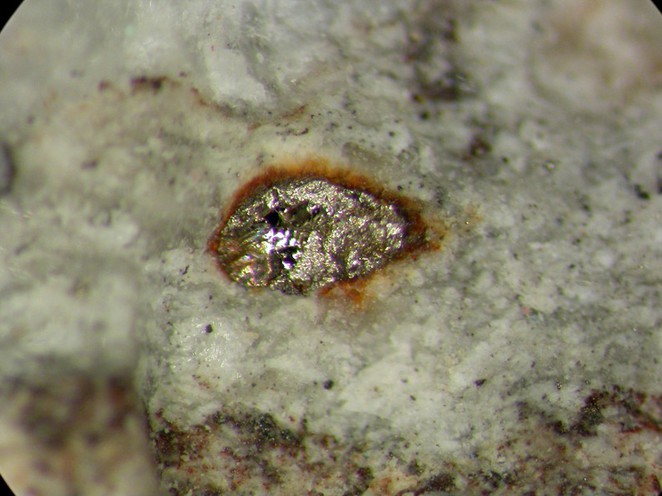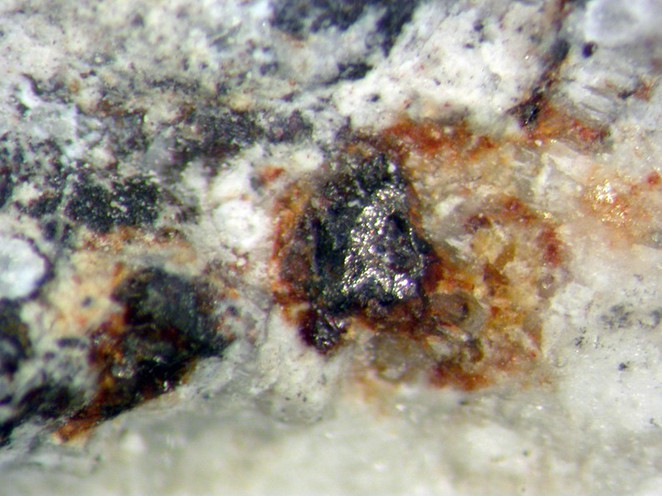Barringerite (original) (raw)
A valid IMA mineral species
About BarringeriteHide
This section is currently hidden. Click the show button to view.
Specific Gravity:
6.92 (Calculated)
Name:
Daniel Moreau Barringer (May 25, 1860, Raleigh, North Carolina, USA – November 30, 1929, Philadelphia, Pennsylvania, USA), early proponent of the meteor impact origin of Meteor Crater, Canyon Diablo, Arizona, USA.
"The Ollague meteorite, as a whole, was artificially annealed at a temperature above 1000°C and that heating gave rise to secondary high-temperature alteration of chemical and phase compositions of this meteorite, including the formation of barringerite." (from Britvin et al 2017).
Unique IdentifiersHide
This section is currently hidden. Click the show button to view.
Long-form identifier:
mindat:1:1:537:5
538e3d2f-1cb1-4aae-b479-9ad7cdaa6a1e
IMA Classification of BarringeriteHide
This section is currently hidden. Click the show button to view.
Classification of BarringeriteHide
This section is currently hidden. Click the show button to view.
1.BD.10
1 : ELEMENTS (Metals and intermetallic alloys; metalloids and nonmetals; carbides, silicides, nitrides, phosphides)
B : Metallic Carbides, Silicides, Nitrides, Phosphides and Hydrides
D : Phosphides
1.1.21.1
1 : NATIVE ELEMENTS AND ALLOYS
1 : Metals, other than the Platinum Group
2.15
2 : Carbides, Nitrides, Silicides and Phosphides
Mineral SymbolsHide
This section is currently hidden. Click the show button to view.
As of 2021 there are now IMA–CNMNC approved mineral symbols (abbreviations) for each mineral species, useful for tables and diagrams.
| Symbol | Source | Reference |
|---|---|---|
| Bgr | IMA–CNMNC | Warr, L.N. (2021). IMA–CNMNC approved mineral symbols. Mineralogical Magazine, 85(3), 291-320. doi:10.1180/mgm.2021.43 |
Pronunciation of BarringeriteHide
This section is currently hidden. Click the show button to view.
Pronunciation:
| Play | Recorded by | Country |
|---|---|---|
| Sorry, your browser doesn't support HTML5 audio. | Jolyon Ralph | United Kingdom |
Physical Properties of BarringeriteHide
This section is currently hidden. Click the show button to view.
Hardness:
VHN20=1097 kg/mm2 - Vickers
Density:
6.92 g/cm3 (Calculated)
Optical Data of BarringeriteHide
This section is currently hidden. Click the show button to view.
Anisotropism:
Noticeable, white to blue
Reflectivity:
| Wavelength | R1 | R2 |
|---|---|---|
| 400nm | 36.5% | 39.3% |
| 420nm | 37.4% | 40.8% |
| 440nm | 38.6% | 42.2% |
| 460nm | 39.7% | 43.3% |
| 480nm | 40.8% | 44.3% |
| 500nm | 42.0% | 45.4% |
| 520nm | 43.4% | 46.4% |
| 540nm | 44.4% | 47.2% |
| 560nm | 45.2% | 47.8% |
| 580nm | 46.2% | 48.6% |
| 600nm | 47.0% | 49.4% |
| 620nm | 47.8% | 50.0% |
| 640nm | 48.7% | 50.7% |
| 660nm | 49.6% | 51.4% |
| 680nm | 50.7% | 52.3% |
| 700nm | 51.8% | 53.1% |
Graph shows reflectance levels at different wavelengths (in nm). Top of box is 100%. Peak reflectance is 53.1%.
R1 shown in black, R2 shown in red
Colour in reflected light:
White. Similar to kamacite, bluish compared to schreibersite.
Chemistry of BarringeriteHide
This section is currently hidden. Click the show button to view.
Crystallography of BarringeriteHide
This section is currently hidden. Click the show button to view.
Class (H-M):
6_m_2 - Ditrigonal Dipyramidal
Cell Parameters:
a = 5.87 Å, c = 3.44 Å
Unit Cell V:
102.65 ų (Calculated from Unit Cell)
Crystal StructureHide
This section is currently hidden. Click the show button to view.
Load
Unit Cell |Unit Cell Packed
2x2x2 |3x3x3 |4x4x4
Show
Big Balls |Small Balls |Just Balls |Spacefill
Polyhedra Off |Si Polyhedra |All Polyhedra
Remove metal-metal sticks
Display Options
Black Background |White Background
Perspective On |Perspective Off
2D |Stereo |Red-Blue |Red-Cyan
View
CIF File Best |x |y |z |a |b |c
Rotation
Stop |Start
Labels
Console Off |On |Grey |Yellow
| ID | Species | Reference | Link | Year | Locality | Pressure (GPa) | Temp (K) |
|---|---|---|---|---|---|---|---|
| 0010499 | Barringerite | Hendricks S B, Kosting P R (1930) The crystal structure of Fe2P, Fe2N, Fe3N and FeB Zeitschrift fur Kristallographie 74 511-533 |  |
1930 | synthetic | 0 | 293 |
| 0010500 | Barringerite | Hendricks S B, Kosting P R (1930) The crystal structure of Fe2P, Fe2N, Fe3N and FeB Zeitschrift fur Kristallographie 74 511-533 |  |
1930 | synthetic | 0 | 293 |
| 0013329 | Barringerite | Carlsson B, Golin M, Rundqvist S (1973) Determination of the homogenity range and refinement of the crystal structure of Fe2P Journal of Solid State Chemistry 8 57-67 | 1973 | synthetic | 0 | 293 | |
| 0014170 | Barringerite | Fujii H, Komura S, Takeda T, Okamoto T, Ito Y, Akimitsu J (1979) Polarized neutron diffraction study of Fe2P single crystal Journal of the Physical Society of Japan 46 1616-1621 | 1979 | synthetic | 0 | 293 | |
| 0014171 | Barringerite | Fujii H, Komura S, Takeda T, Okamoto T, Ito Y, Akimitsu J (1979) Polarized neutron diffraction study of Fe2P single crystal Journal of the Physical Society of Japan 46 1616-1621 | 1979 | synthetic | 0 | 293 |
CIF Raw Data - click here to close
X-Ray Powder DiffractionHide
This section is currently hidden. Click the show button to view.
Powder Diffraction Data:
| d-spacing | Intensity |
|---|---|
| 2.237 Å | (100) |
| 1.28 Å | (100) |
| 1.21 Å | (100) |
| 1.10 Å | (100) |
| 2.048 Å | (95) |
| 1.920 Å | (90) |
| 1.694 Å | (80) |
Comments:
Pattern of synthetic Fe2P
Geological EnvironmentHide
This section is currently hidden. Click the show button to view.
Geological Setting:
As a single grain in a brecciated lunar meteorite of mixed mare and highland origin; in the oxidation zone of a platinum-bearing Cu-Ni sulphide deposit
Type Occurrence of BarringeriteHide
This section is currently hidden. Click the show button to view.
General Appearance of Type Material:
As bands, 10-15 µm wide and several hundred µm long, consisting of individual grains less than 1 µm in diameter.
Place of Conservation of Type Material:
Nininger collection, Center for Meteorite Studies, Arizona State University, Tempe, Arizona, USA.
Geological Setting of Type Material:
Along the contact between schreibersite and troilite in a Fe-Ni meteorite.
Associated Minerals at Type Locality:
Synonyms of BarringeriteHide
This section is currently hidden. Click the show button to view.
Other Language Names for BarringeriteHide
This section is currently hidden. Click the show button to view.
Relationship of Barringerite to other SpeciesHide
This section is currently hidden. Click the show button to view.
Other Members of this group:
Common AssociatesHide
This section is currently hidden. Click the show button to view.
Associated Minerals Based on Photo Data:
Related Minerals - Strunz-mindat GroupingHide
This section is currently hidden. Click the show button to view.
Other InformationHide
This section is currently hidden. Click the show button to view.
Notes:
Devoid of ferromagnetic properties (Curie point 7 deg C).
Health Risks:
No information on health risks for this material has been entered into the database. You should always treat mineral specimens with care.
Internet Links for BarringeriteHide
This section is currently hidden. Click the show button to view.
References for BarringeriteHide
This section is currently hidden. Click the show button to view.
Reference List:
Localities for BarringeriteHide
This section is currently hidden. Click the show button to view.
This map shows a selection of localities that have latitude and longitude coordinates recorded. Click on the  symbol to view information about a locality. The
symbol to view information about a locality. The  symbol next to localities in the list can be used to jump to that position on the map.
symbol next to localities in the list can be used to jump to that position on the map.
Locality ListHide
This section is currently hidden. Click the show button to view.
 - This locality has map coordinates listed.
- This locality has map coordinates listed.  - This locality has estimated coordinates. ⓘ - Click for references and further information on this occurrence. ? - Indicates mineral may be doubtful at this locality.
- This locality has estimated coordinates. ⓘ - Click for references and further information on this occurrence. ? - Indicates mineral may be doubtful at this locality.  - Good crystals or important locality for species.
- Good crystals or important locality for species.  - World class for species or very significant. (TL) - Type Locality for a valid mineral species. (FRL) - First Recorded Locality for everything else (eg varieties).
- World class for species or very significant. (TL) - Type Locality for a valid mineral species. (FRL) - First Recorded Locality for everything else (eg varieties). Struck out - Mineral was erroneously reported from this locality. Faded * - Never found at this locality but inferred to have existed at some point in the past (e.g. from pseudomorphs).
All localities listed without proper references should be considered as questionable.


